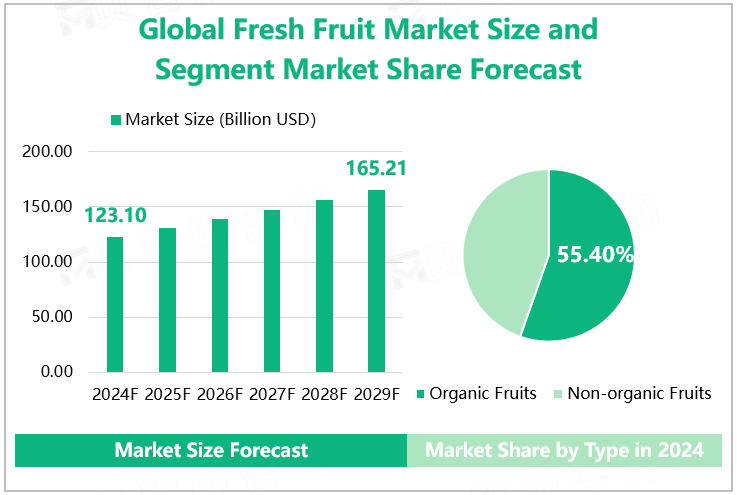Fresh fruits, usually with a glossy appearance, thin skin, rich aroma, sweet taste, and relatively richer nutritional content, refer to those that have just been picked or recently picked. These fruits not only contain a large amount of water and carbohydrates but are also rich in nutrients such as vitamins and minerals, which are very beneficial for people's physical health.
According to taste classification, fresh fruits can be divided into sweet fruits and sour fruits. Sweet fruits such as apples, bananas, grapes, etc. have a sweet taste and are loved by people; Sour fruits such as lemon and lime, although slightly sour, are rich in vitamin C and have unique nutritional value.
Overview of Market Development
From a global perspective, the fresh fruit market has shown a steady growth trend. This is due to consumers' pursuit of healthy eating and the continuous development of global trade. According to our research data, the global fresh fruit market is estimated to reach $123.03 billion in 2024, an increase of 5.84% compared to 2023.
Market development prospects and trend prediction
It is expected that in the coming years, as people's awareness of nutritional value continues to increase, the demand for fresh fruits will continue to grow. Meanwhile, with the continuous progress of cold chain logistics and preservation technology, the supply of fresh fruits will also become more stable. It is expected that by 2029, the global fresh fruit market size will increase to $165.06 billion.
From the perspective of market development trends, as consumers demand higher quality and safety, fruits with concepts such as organic, green, and pollution-free are increasingly favored by more and more people. Meanwhile, with the acceleration of the pace of life, convenient and fast purchasing methods have also become the preferred choice for consumers. Therefore, emerging channels such as e-commerce platforms and community group buying are gradually emerging, becoming important sales channels in the fresh fruit market.
Segmented market analysis
From the perspective of product types, fresh fruits can be divided into two categories: organic fruits and non-organic fruits based on whether chemically synthesized pesticides, fertilizers, and growth regulators are used in the planting and production process. Organic fruits follow the production standards of organic agriculture during the planting process, emphasizing ecological balance and sustainable development. The use of the aforementioned chemicals is prohibited, and instead, natural methods and substances are used to regulate crop growth. Therefore, organic fruits are often considered healthier and more environmentally friendly; Non-organic fruits may use chemically synthesized pesticides, fertilizers, etc. during the planting process to increase yield and control pests and diseases. Although these chemicals to some extent ensure the yield and appearance of fruits, they may also pose potential hazards to human health and the environment.
Research has shown that organic fresh fruits occupy a larger market share among the two types of fresh fruits. Data shows that the global organic fresh fruit market is expected to reach $68.20 billion in 2024, with an estimated market share of 55.40%.
Global Fresh Fruit Market Size and Segment Market Share Forecast

Source: www.globalmarketmonitor.com
Market Analysis of Major Regions
From a regional perspective, the global fresh fruit market is mainly concentrated in North America, Europe, and the Asia Pacific region. Among them, North America is the largest revenue market. Data shows that the revenue of the North American fresh fruit market is expected to reach $40.41 billion in 2024, with an estimated market share of 32.83%; The Asia Pacific and European markets are expected to rank second and third with 32.38% and 28.73% respectively.
Global Fresh Fruit Market Revenue and Market Share by Region Forecast in
2024
|
Regions
|
Market Revenue (Billion USD)
|
Market Share
|
|
North America
|
40.41
|
32.83%
|
|
Europe
|
35.37
|
28.73%
|
|
Asia Pacific
|
39.86
|
32.38%
|
|
South America
|
4.17
|
3.39%
|
|
Middle East & Africa
|
3.29
|
2.67%
|
Source: www.globalmarketmonitor.com
For more industry information, please refer to our latest released "Fresh Fruit Market - Global Professional Analysis and Forecast to 2026".
